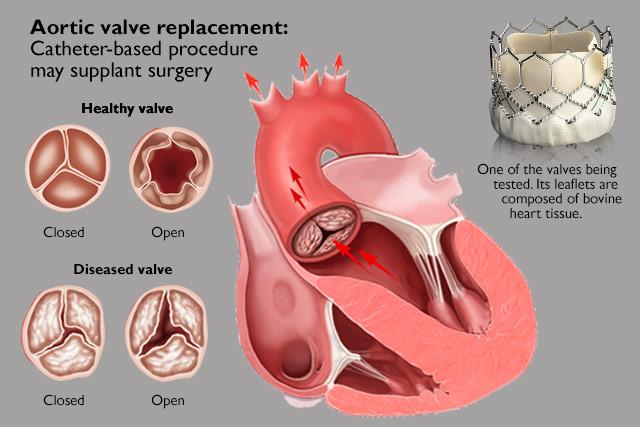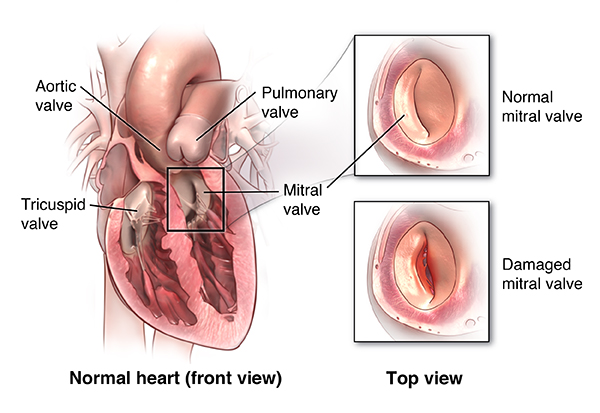Heart valve repair is usually the first choice because it is associated with a lower risk of infection, preserves valve strength and function, and reduces the need to take blood-thinning medications for the rest of your life,
Heart valve surgery is a procedure to treat heart valve disease. Heart valve disease involves at least one of the four heart valves not working properly. Heart valves keep blood flowing in the correct direction through your heart.
The four valves are the mitral valve, tricuspid valve, pulmonary valve and aortic valve. Each valve has flaps — called leaflets for the mitral and tricuspid valves and cusps for the aortic and pulmonary valves. These flaps open and close once during each heartbeat. Valves that don’t open or close properly disrupt blood flow through your heart to your body.

AORTIC VALVE REPAIR (TISSUE / MECHANICAL)
The aortic valve helps keep blood flowing in the correct direction through the heart. It separates the heart’s main pumping chamber (left ventricle) and the main artery that supplies oxygen-rich blood to your body (aorta).
With each contraction of the ventricle, the aortic valve opens and allows blood to flow from the left ventricle into the aorta. When the ventricle relaxes, the aortic valve closes to prevent blood from flowing backward into the ventricle.
When the aortic valve isn’t working properly, it can interfere with blood flow and force the heart to work harder to send blood to the rest of your body.
Aortic valve repair or aortic valve replacement can treat aortic valve disease and help restore normal blood flow, reduce symptoms, prolong life and help preserve the function of your heart muscle.
Transcatheter aortic valve replacement (TAVR) is a minimally invasive heart procedure to replace a narrowed aortic valve that fails to open properly (aortic valve stenosis). Transcatheter aortic valve replacement is sometimes called transcatheter aortic valve implantation (TAVI).

MITRAL VALVE REPLACEMENT ( TISSUE / MECHNICAL )
The mitral valve is a bileaflet valve sited between the left atrium and left ventricle, responsible for preventing blood flowing from the atrium to the ventricle when the heart contracts
Mitral valve replacement is a procedure whereby the diseased mitral valve of a patient’s heart is replaced by either a mechanical or tissue (bioprosthetic) valve. The mitral valve is 1 of the heart’s 4 valves. It helps blood flow through the heart and out to the body. The mitral valve lies between the left atrium and the left ventricle.
The mitral valve may need to be replaced because:
- The valve is leaky
- The valve is narrowed and doesn’t open properly.
Causes of mitral valve disease include infection, calcification and inherited collagen disease. Current mitral valve replacement approaches include open heart surgery and minimally invasive cardiac surgery (MICS).
There are two main types of artificial mitral valve: mechanical valves and tissue (bioprosthetic) valves.
Mechanical valves
Mechanical valves are made from metal and/or pyrolitic carbon, and can last 20–30 years.
The risk of blood clots forming is higher with mechanical valves than with bioprosthetic valves.
Tissue valves
Tissue / Bioprosthetic valves are made from animal tissues. Most people with bioprosthetic valves don’t need to take anticoagulants long term. They tend to deteriorate more quickly in younger patients. New tissue preservation technologies are being studied to try to increase the durability of bioprosthetic valves.
Patients with a bioprosthetic mitral valve are prescribed anticoagulants, such as warfarin, for 6 weeks to 3 months after their operation, while patients with mechanical valves are prescribed anticoagulants for the rest of their lives. Anticoagulants are taken to prevent blood clots, which can move to other parts of the body and cause serious medical problems, such as a heart attack.

